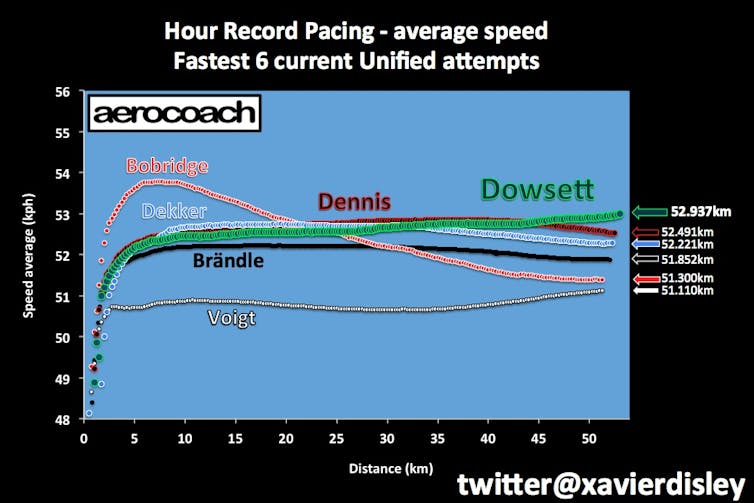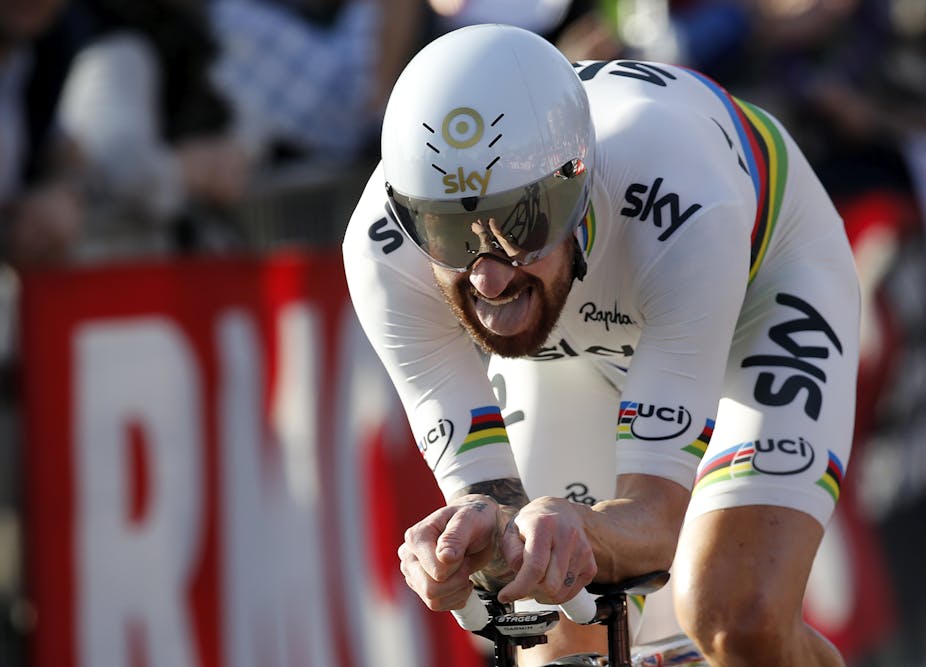The challenge for Bradley Wiggins is beautifully simple: complete the greatest number of laps of a velodrome track in one hour by pedalling as close as possible to the black racing line. However, the simplicity is deceptive, the pain is intense, and cycling’s hour record requires meticulous preparation in terms of equipment, training and strategy in order to have the best chance of success.
The wind can be a friend to the cyclist, but is more often the foe. This is because the power needed to overcome drag rises in proportion to the cube of velocity, so at 50kmph, more than 90% of the rider’s power output is spent fighting the wind.
A skilled road racer can use the wind to their advantage by slipstreaming to save energy before choosing the prime moment to attack, but when the rider is alone against the clock there is no place to hide. This is why the time-trial is known as the “race of truth” and the hour record, which is held under relatively stable conditions in a velodrome, is possibly the perfect time-trial.
Marginal gains
Alex Dowsett is the current holder of the hour record in a year which has seen a glut of attempts after the sport’s governing body eased back on the rules. On May 2, Dowsett rode to a remarkable distance of 52.937km (Wiggins is targeting 55.250km).
I was lucky enough to help construct the training plan which got Alex there, and the experience offers up some useful insights into just what it takes.

Since Francesco Moser’s successful attempt in 1984 (51.151 km) when he adopted a special skinsuit, disc wheels and low-profile frame, aerodynamics have featured prominently in the technical preparation. People may remember the intriguing battle between Graeme Obree and Chris Boardman as they traded blows over the record and adopted a range of startling on-bike positions in the pursuit of aerodynamic advantage.
Current rules on equipment and riding position are still strict, so any gains come from refinements that take many hours of wind tunnel testing. But they can be found.
Even something as simple as the skinsuit and socks underwent numerous redesigns for Alex‘s attempt to ensure the fabric and fit produced minimal drag. In fact every possible trick of engineering and physics was afforded Alex from the use of custom aero equipment like the disc wheels, frame, handlebars and helmet through to the use of low viscosity lubricants and ceramic bearings.
We even estimated that by heating the velodrome to 28-29 degrees celsius, the reduction in air density and subsequent drag would more than compensate for any loss of performance due to dehydration – although he did still take the precaution of precooling with an ice jacket.
Easing off
Training for the hour is pretty similar to tuning an engine. The key to effective physical preparation is to ensure the training is correctly sequenced and monitored to optimise gains in fitness whilst avoiding overtraining. By employing mostly high volume endurance riding with regular intense intervals and carefully timed races, Alex’s fitness was systematically developed with the goal of generating greater power output for the same blood lactate concentration and heart rate.
However, improvements are often masked by accumulated fatigue so a taper was employed prior to the event whereby training load, but not intensity, was reduced to help recovery without compromising fitness. In spite of research, tapering is still very much an art with many cyclists under-performing if they feel “too fresh”: sometimes as a coach you really can be too good.

The hour record is an aerobic event, in fact the intake of air is pretty crucial you might say. But it also demands a significant contribution from those anaerobic Type II muscle fibres which don’t get their energy from oxygen and which are engaged at the tortuous start when the rider is trying to churn a massive gear into life.
Theory states that provided the athlete maintains an even pacing strategy at a power output where heart rate, oxygen uptake and blood lactate concentration remain close to a steady state, then the maximum speed should be achieved. Not only is this sweet spot difficult to judge, but the hour record is raced from a standing start that threatens to immediately over-tax the anaerobic systems which tire quickly. The dilemma for Wiggins will be the same as for every hour record racer: go out too slow and valuable speed is lost; too fast and you are plunged into an oxygen deficit that takes dozens of laps to repay.
The precise mechanisms of fatigue are hotly debated in the literature but what we do know is that as time passes any theoretical steady state is lost: fuel is burnt, chemicals build up which contribute to exhaustion, water is lost and heat accumulates.
The postural muscles throughout the body which maintain the rider’s unnatural aerodynamic position struggle under the strain of high cornering forces and the fixed wheel becomes an instrument of torture with no break from the relentless rhythm of pedalling – there is no freewheeling relief on a track bike. There is some respite as the bike accelerates through each bend, but this is accompanied by an abrupt drop in speed at the start of the following straight. Consequently, the perception of effort rises and the rider’s willpower to continue and ability to hold the line are tested.
Pace planning
And so to the biggest deception of all. During the opening 20 minutes the pace is easily manageable with the freshness of the taper, the warm air, the full aero package and low friction components. The speed is “free” and the temptation to ride too fast is great: many have. The previous record holder, Australia’s Rohan Dennis (52.491km), almost paid the price of an ambitious start to slow significantly later on. And it is not hard to pick out Jack Bobridge’s failed attempt from the chart below.

Alex’s hour on the other hand was well-drilled with the pace rehearsed over thousands of training laps. He rode to a strict schedule, never going too deep, never accumulating a debt he could not repay. And in the last third of the race, confident that he had budgeted wisely, he attacked Dennis’s record.
Was his a “perfect hour” as it was dubbed by his sponsors, or was it too respectful? Maybe it was the euphoria of success, but Alex didn’t show the usual signs of exhaustion at the finish, even lifting his bike above his head in celebration. What is for certain is that Wiggins, having openly pledged to set a record that will stand for many years, cannot afford to hold anything back, not even in the first 20 minutes.

